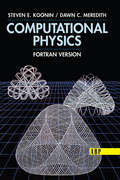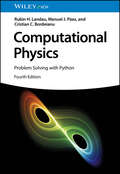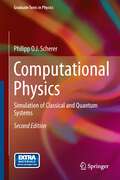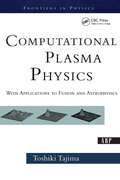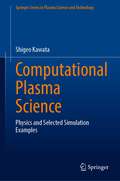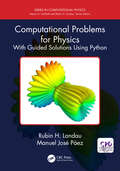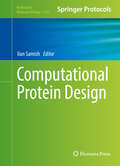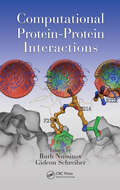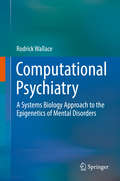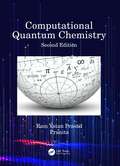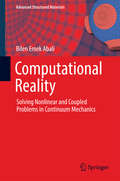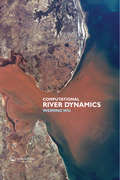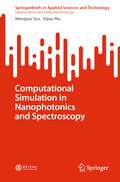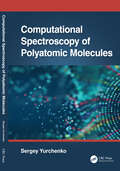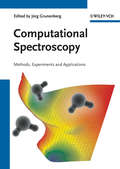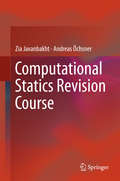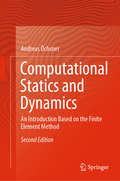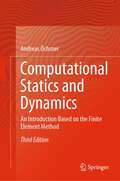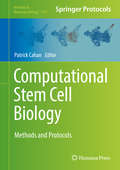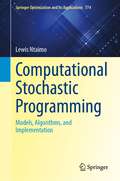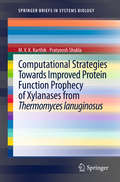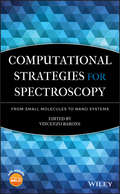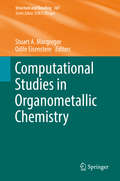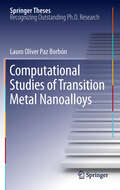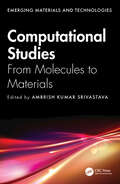- Table View
- List View
Computational Physics: Fortran Version
by Steven E. KooninComputational Physics is designed to provide direct experience in the computer modeling of physical systems. Its scope includes the essential numerical techniques needed to "do physics" on a computer. Each of these is developed heuristically in the text, with the aid of simple mathematical illustrations. However, the real value of the book is in the eight Examples and Projects, where the reader is guided in applying these techniques to substantial problems in classical, quantum, or statistical mechanics. These problems have been chosen to enrich the standard physics curriculum at the advanced undergraduate or beginning graduate level. The book will also be useful to physicists, engineers, and chemists interested in computer modeling and numerical techniques. Although the user-friendly and fully documented programs are written in FORTRAN, a casual familiarity with any other high-level language, such as BASIC, PASCAL, or C, is sufficient. The codes in BASIC and FORTRAN are available on the web at http://www.computationalphysics.info. They are available in zip format, which can be expanded on UNIX, Window, and Mac systems with the proper software. The codes are suitable for use (with minor changes) on any machine with a FORTRAN-77 compatible compiler or BASIC compiler. The FORTRAN graphics codes are available as well. However, as they were originally written to run on the VAX, major modifications must be made to make them run on other machines.
Computational Physics: Problem Solving with Python
by Cristian C. Bordeianu Rubin H. Landau Manuel J. PáezComputational Physics The classic in the field for more than 25 years, now with increased emphasis on data science and new chapters on quantum computing, machine learning (AI), and general relativity Computational physics combines physics, applied mathematics, and computer science in a cutting-edge multidisciplinary approach to solving realistic physical problems. It has become integral to modern physics research because of its capacity to bridge the gap between mathematical theory and real-world system behavior. Computational Physics provides the reader with the essential knowledge to understand computational tools and mathematical methods well enough to be successful. Its philosophy is rooted in “learning by doing”, assisted by many sample programs in the popular Python programming language. The first third of the book lays the fundamentals of scientific computing, including programming basics, stable algorithms for differentiation and integration, and matrix computing. The latter two-thirds of the textbook cover more advanced topics such linear and nonlinear differential equations, chaos and fractals, Fourier analysis, nonlinear dynamics, and finite difference and finite elements methods. A particular focus in on the applications of these methods for solving realistic physical problems. Readers of the fourth edition of Computational Physics will also find: An exceptionally broad range of topics, from simple matrix manipulations to intricate computations in nonlinear dynamicsA whole suite of supplementary material: Python programs, Jupyter notebooks and videos Computational Physics is ideal for students in physics, engineering, materials science, and any subjects drawing on applied physics.
Computational Physics: Simulation of Classical and Quantum Systems (Graduate Texts in Physics)
by Philipp O.J. SchererThis textbook presents basic and advanced computational physics in a very didactic style. It contains very-well-presented and simple mathematical descriptions of many of the most important algorithms used in computational physics. Many clear mathematical descriptions of important techniques in computational physics are given. The first part of the book discusses the basic numerical methods. A large number of exercises and computer experiments allows to study the properties of these methods. The second part concentrates on simulation of classical and quantum systems. It uses a rather general concept for the equation of motion which can be applied to ordinary and partial differential equations. Several classes of integration methods are discussed including not only the standard Euler and Runge Kutta method but also multistep methods and the class of Verlet methods which is introduced by studying the motion in Liouville space. Besides the classical methods, inverse interpolation is discussed, together with the popular combined methods by Dekker and Brent and a not so well known improvement by Chandrupatla. A general chapter on the numerical treatment of differential equations provides methods of finite differences, finite volumes, finite elements and boundary elements together with spectral methods and weighted residual based methods. A comparison of several methods for quantum systems is performed, containing pseudo-spectral methods, finite differences methods, rational approximation to the time evolution operator, second order differencing and split operator methods.The book gives simple but non trivial examples from a broad range of physical topics trying to give the reader insight into the numerical treatment but also the simulated problems. Rotational motion is treated in much detail to describe the motion of rigid rotors which can be just a simple spinning top or a collection of molecules or planets. The behaviour of simple quantum systems is studied thoroughly. One focus is on a two level system in an external field. Solution of the Bloch equations allows the simulation of a quantum bit and to understand elementary principles from quantum optics. As an example of a thermodynamic system, the Lennard Jones liquid is simulated. The principles of molecular dynamics are shown with practical simulations. A second thermodynamic topic is the Ising model in one and two dimensions. The solution of the Poisson Boltzman equation is discussed in detail which is very important in Biophysics as well as in semiconductor physics. Besides the standard finite element methods, also modern boundary element methods are discussed. Waves and diffusion processes are simulated. Different methods are compared with regard to their stability and efficiency. Random walk models are studied with application to basic polymer physics. Nonlinear systems are discussed in detail with application to population dynamics and reaction diffusion systems. The exercises to the book are realized as computer experiments. A large number of Java applets is provided. It can be tried out by the reader even without programming skills. The interested reader can modify the programs with the help of the freely available and platform independent programming environment "netbeans".
Computational Plasma Physics: With Applications To Fusion And Astrophysics (Frontiers in Physics)
by Toshi TajimaThe physics of plasmas is an extremely rich and complex subject as the variety of topics addressed in this book demonstrates. This richness and complexity demands new and powerful techniques for investigating plasma physics. An outgrowth from his graduate course teaching, now with corrections, Tajima's text provides not only a lucid introduction to computational plasma physics, but also offers the reader many examples of the way numerical modeling, properly handled, can provide valuable physical understanding of the nonlinear aspects so often encountered in both laboratory and astrophysical plasmas. Included here are computational methods for modern nonlinear physics as applied to hydrodynamic turbulence, solitons, fast reconnection of magnetic fields, anomalous transports, dynamics of the sun, and more. The text contains examples of problems now solved using computational techniques including those concerning finite-size particles, spectral techniques, implicit differencing, gyrokinetic approaches, and particle simulation.
Computational Plasma Science: Physics and Selected Simulation Examples (Springer Series in Plasma Science and Technology)
by Shigeo KawataThe book presents fundamentals of plasma physics with rich references and computational techniques in a concise manner. It particularly focuses on introductions to numerical simulation methods in plasma physics, in addition to those to physics and mathematics in plasma physics. It also presents the fundamentals of numerical methods, which solve mathematical models of plasmas, together with examples of numerical results. A discretization method, the so-called finite difference method, is introduced for particle-in-cell methods and fluid codes, which have been widely employed in plasma physics studies. In addition to the introduction to numerical solutions, it also covers numerical stability. The instabilities and numerical errors significantly influence the results, and for correct results, great efforts are required to avoid such numerical artifacts. The book also carefully discusses the numerical errors, numerical stability, and uncertainty in numerical computations. Readers are expected to have an understanding of fundamental physics of mechanics, electromagnetism, thermodynamics, statistical physics, relativity, fluid dynamics, and mathematics, but the book does not assume background knowledge on plasma. Therefore, it is a first book of plasma physics for upper undergraduate and early graduate students who are interested in learning it.
Computational Problems for Physics: With Guided Solutions Using Python (Series in Computational Physics)
by Rubin H. Landau Manuel José PáezOur future scientists and professionals must be conversant in computational techniques. In order to facilitate integration of computer methods into existing physics courses, this textbook offers a large number of worked examples and problems with fully guided solutions in Python as well as other languages (Mathematica, Java, C, Fortran, and Maple). It’s also intended as a self-study guide for learning how to use computer methods in physics. The authors include an introductory chapter on numerical tools and indication of computational and physics difficulty level for each problem. Readers also benefit from the following features: • Detailed explanations and solutions in various coding languages. • Problems are ranked based on computational and physics difficulty. • Basics of numerical methods covered in an introductory chapter. • Programming guidance via flowcharts and pseudocode. Rubin Landau is a Distinguished Professor Emeritus in the Department of Physics at Oregon State University in Corvallis and a Fellow of the American Physical Society (Division of Computational Physics). Manuel Jose Paez-Mejia is a Professor of Physics at Universidad de Antioquia in Medellín, Colombia.
Computational Protein Design (Methods in Molecular Biology #1529)
by Ilan SamishThe aim this volume is to present the methods, challenges, software, and applications of this widespread and yet still evolving and maturing field. Computational Protein Design, the first book with this title, guides readers through computational protein design approaches, software and tailored solutions to specific case-study targets. Written in the highly successful Methods in Molecular Biology series format, chapters include introductions to their respective topics, step-by-step, readily reproducible laboratory protocols, and tips on troubleshooting and avoiding known pitfalls. Authoritative and cutting-edge, Computational Protein Design aims to ensure successful results in the further study of this vital field.
Computational Protein-Protein Interactions
by Ruth Nussinov Gideon SchreiberOften considered the workhorse of the cellular machinery, proteins are responsible for functions ranging from molecular motors to signaling. The broad recognition of their involvement in all cellular processes has led to focused efforts to predict their functions from sequences, and if available, from their structures. An overview of current resear
Computational Psychiatry: A Systems Biology Approach to the Epigenetics of Mental Disorders
by Rodrick WallaceThis book explores mental disorders from a uniquely evolutionary perspective. Although there have been many attempts to mathematically model neural processes and, to some extent, their dysfunction, there is very little literature that models mental function within a sociocultural, socioeconomic, and environmental context. Addressing this gap in the extant literature, this book explores essential aspects of mental disorders, recognizing the ubiquitous role played by the exaptation of crosstalk between cognitive modules at many different scales and levels of organization, the missing heritability of complex diseases, and cultural epigenetics. Further, it introduces readers to valuable control theory tools that permit the exploration of the environmental induction of neurodevelopmental disorders, as well as the study of the synergism between culture, psychopathology and sleep disorders, offering a distinctively unique resource.
Computational Quantum Chemistry
by Ram Yatan Prasad PranitaComputational Quantum Chemistry, Second Edition, is an extremely useful tool for teaching and research alike. It stipulates information in an accessible manner for scientific investigators, researchers and entrepreneurs. The book supplies an overview of the field and explains the fundamental underlying principles. It also gives the knowledge of numerous comparisons of different methods. The book consists of a wider range of applications in each chapter. It also provides a number of references which will be useful for academic and industrial researchers. It includes a large number of worked-out examples and unsolved problems for enhancing the computational skill of the users. Features Includes comprehensive coverage of most essential basic concepts Achieves greater clarity with improved planning of topics and is reader-friendly Deals with the mathematical techniques which will help readers to more efficient problem solving Explains a structured approach for mathematical derivations A reference book for academicians and scientific investigators Ram Yatan Prasad, PhD, DSc (India), DSc (hc) Colombo, is a Professor of Chemistry and former Vice Chancellor of S.K.M University, Jharkhand, India. Pranita, PhD, DSc (hc) Sri Lanka, FICS, is an Assistant Professor of Chemistry at Vinoba Bhave University, India.
Computational Reality: Solving Nonlinear and Coupled Problems in Continuum Mechanics (Advanced Structured Materials #55)
by Bilen Emek AbaliThis book presents the theory of continuum mechanics for mechanical, thermodynamical, and electrodynamical systems. It shows how to obtain governing equations and it applies them by computing the reality. It uses only open-source codes developed under the FEniCS project and includes codes for 20 engineering applications from mechanics, fluid dynamics, applied thermodynamics, and electromagnetism. Moreover, it derives and utilizes the constitutive equations including coupling terms, which allow to compute multiphysics problems by incorporating interactions between primitive variables, namely, motion, temperature, and electromagnetic fields. An engineering system is described by the primitive variables satisfying field equations that are partial differential equations in space and time. The field equations are mostly coupled and nonlinear, in other words, difficult to solve. In order to solve the coupled, nonlinear system of partial differential equations, the book uses a novel collection of open-source packages developed under the FEniCS project. All primitive variables are solved at once in a fully coupled fashion by using finite difference method in time and finite element method in space.
Computational River Dynamics
by Weiming WuComprehensive text on the fundamentals of modeling flow and sediment transport in rivers treating both physical principles and numerical methods for various degrees of complexity. Includes 1-D, 2-D (both depth- and width-averaged) and 3-D models, as well as the integration and coupling of these models. Contains a broad selection
Computational Simulation in Nanophotonics and Spectroscopy (SpringerBriefs in Applied Sciences and Technology)
by Mengtao Sun Xijiao MuNanophotonics and spectroscopy has advanced rapidly in recent years. Experimental research on nanophotonics is very active. In addition to experimental research on the principles and applications of nanophotonics, computational simulation research on its various physical mechanisms and phenomena is equally important. The simulation of the optical properties of molecules or crystals, such as electronic spectra (absorption and emission spectra, etc.) and vibrational spectroscopy has extraordinary guiding significance for experiments. The current computational simulation technology can also explain and analyze the physical mechanisms behind phenomena. However, among the many computational simulation software programs available, the operation methods and application scenarios are different. The barrier for new users to conduct research with computational simulation is high. Even for researchers with some experience, it is not easy to develop a comprehensive understanding of the various software programs, keywords, programming languages and auxiliary programs. This book serves as an introductory book for beginners to get started with the technology, and a handbook for experienced readers to quickly look up for commands and script usage. It is a handy reference for graduate students and researchers engaged in the study of photonics and optics.
Computational Spectroscopy of Polyatomic Molecules
by Sergey YurchenkoThis book provides a detailed description of the modern variational methods available for solving the nuclear motion Schrödinger equation to enable accurate theoretical spectroscopy of polyatomic molecules. These methods are currently used to provide important molecular data for spectroscopic studies of atmospheres of astronomical objects including solar and extrasolar planets as well as cool stars. This book has collected descriptions of quantum mechanical methods into one cohesive text, making the information more accessible to the scientific community, especially for young researchers, who would like to devote their scientific career to the field of computational molecular physics. The book addresses key aspects of the high-accuracy computational spectroscopy of the medium size polyatomic molecules. It aims to describe numerical algorithms for the construction and solution of the nuclear motion Schrödinger equations with the central idea of the modern computational spectroscopy of polyatomic molecules to include the construction of the complex kinetic energy operators (KEO) into the computation process of the numerical pipeline by evaluating the corresponding coefficients of KEO derivatives on-the-fly. The book details key aspects of variational solutions of the nuclear motion Schrödinger equations targeting high accuracy, including construction of rotational and vibrational basis functions, coordinate choice, molecular symmetry as well as of intensity calculations and refinement of potential energy functions. The goal of this book is to show how to build an accurate spectroscopic computational protocol in a pure numerical manner of a general black-box type algorithm. This book will be a valuable resource for researchers, both experts and not experts, working in the area of the computational and experimental spectroscopy; PhD students and early-career spectroscopists who would like to learn basics of the modern variational methods in the field of computational spectroscopy. It will also appeal to astrophysicists and atmospheric physicists who would like to assess data and perform calculations themselves. Key features: Supported by the latest research and based on the state-of-the-art computational methods in high-accuracy computational spectroscopy of molecules. Authored by an authority in the field. Accessible to both experts and non-experts working in the area of computational and experimental spectroscopy, in addition to graduate students.
Computational Spectroscopy: Methods, Experiments and Applications
by Jörg GrunenbergUnique in its comprehensive coverage of not only theoretical methods but also applications in computational spectroscopy, this ready reference and handbook compiles the developments made over the last few years, from single molecule studies to the simulation of clusters and the solid state, from organic molecules to complex inorganic systems and from basic research to commercial applications in the area of environment relevance. In so doing, it covers a multitude of apparatus-driven technologies, starting with the common and traditional spectroscopic methods, more recent developments (THz), as well as rather unusual methodologies and systems, such as the prediction of parity violation, rare gas HI complexes or theoretical spectroscopy of the transition state. With its summarized results of so many different disciplines, this timely book will be of interest to newcomers to this hot topic while equally informing experts about developments in neighboring fields.
Computational Statics Revision Course
by Andreas Öchsner Zia JavanbakhtThis revision and work book offers a very specific concept for learning the finite element method applying it to problems from statics of: It skips all the classical derivations and focusses only the essential final results. Based on these `essentials', fully solved example problems are presented. To facilitate the initial learning process, the authors compiled 10 recommended steps for a linear finite element solution procedure (`hand calculation') and all the solved examples follow this simple scheme. These 10 recommended steps help engineering students to master the finite element method and guide through fundamental standard problems, although there are neither 10 recommended steps for real-life engineering pro blems nor 10 standard problems that cover all possible problems that a young engineer may face during his first years of professional work. This revision course accompanies the textbook "Computational Statics and Dyn amics: An Introduction Based on the Finite Element Method" by the same authors.
Computational Statics and Dynamics: An Introduction Based on the Finite Element Method
by Andreas ÖchsnerThis book is the 2nd edition of an introduction to modern computational mechanics based on the finite element method. It includes more details on the theory, more exercises, and more consistent notation; in addition, all pictures have been revised. Featuring more than 100 pages of new material, the new edition will help students succeed in mechanics courses by showing them how to apply the fundamental knowledge they gained in the first years of their engineering education to more advanced topics. In order to deepen readers’ understanding of the equations and theories discussed, each chapter also includes supplementary problems. These problems start with fundamental knowledge questions on the theory presented in the respective chapter, followed by calculation problems. In total, over 80 such calculation problems are provided, along with brief solutions for each. This book is especially designed to meet the needs of Australian students, reviewing the mathematics covered in their first two years at university. The 13-week course comprises three hours of lectures and two hours of tutorials per week.
Computational Statics and Dynamics: An Introduction Based on the Finite Element Method
by Andreas ÖchsnerThis book is the 3rd edition of an introduction to modern computational mechanics based on the finite element method. This third edition is largely extended, adding many new examples to let the reader understand the principles better by performing calculations by hand, as well as numerical example to practice the finite element approach to engineering problems. The new edition comes together with a set of digital flash cards with questions and answers that improve learning success. Featuring over 100 more pages, the new edition will help students succeed in mechanics courses by showing them how to apply the fundamental knowledge they gained in the first years of their engineering education to more advanced topics. In order to deepen readers’ understanding of the equations and theories discussed, each chapter also includes supplementary problems. These problems start with fundamental knowledge questions on the theory presented in the respective chapter, followed by calculation problems. In total, over 80 such calculation problems are provided, along with brief solutions for each. Test your knowledge with questions and answers about the book in the Springer Nature Flashcards app.
Computational Stem Cell Biology: Methods and Protocols (Methods in Molecular Biology #1975)
by Patrick CahanThis volume details methods and protocols to further the study of stem cells within the computational stem cell biology (CSCB) field. Chapters are divided into four sections covering the theory and practice of modeling of stem cell behavior, analyzing single cell genome-scale measurements, reconstructing gene regulatory networks, and metabolomics. Written in the highly successful Methods in Molecular Biology series format, chapters include introductions to their respective topics, lists of the necessary materials and reagents, step-by-step, readily reproducible laboratory protocols, and tips on troubleshooting and avoiding known pitfalls.Authoritative and cutting-edge, Computational Stem Cell Biology: Methods and Protocols will be an invaluable guide to researchers as they explore stem cells from the perspective of computational biology.
Computational Stochastic Programming: Models, Algorithms, and Implementation (Springer Optimization and Its Applications #774)
by Lewis NtaimoThis book provides a foundation in stochastic, linear, and mixed-integer programming algorithms with a focus on practical computer algorithm implementation. The purpose of this book is to provide a foundational and thorough treatment of the subject with a focus on models and algorithms and their computer implementation. The book’s most important features include a focus on both risk-neutral and risk-averse models, a variety of real-life example applications of stochastic programming, decomposition algorithms, detailed illustrative numerical examples of the models and algorithms, and an emphasis on computational experimentation. With a focus on both theory and implementation of the models and algorithms for solving practical optimization problems, this monograph is suitable for readers with fundamental knowledge of linear programming, elementary analysis, probability and statistics, and some computer programming background. Several examples of stochastic programming applications areincluded, providing numerical examples to illustrate the models and algorithms for both stochastic linear and mixed-integer programming, and showing the reader how to implement the models and algorithms using computer software.
Computational Strategies Towards Improved Protein Function Prophecy of Xylanases from Thermomyces lanuginosus (SpringerBriefs in Systems Biology #4)
by Pratyoosh Shukla Mvk KarthikThis Brief reports on the interplay of an amino-acid mutation towards substrate which could lead to enhanced effects on mutant. These effects need to be given consideration in the engineering processes of protein stability and further exploration of such learning are required to provide novel indication for selection of an enzymes. There are very few reports showing such stable, energy efficient model towards improved protein function prediction screening in-silico structure based mutagenesis of xylanases from Thermomyces lanuginosus
Computational Strategies for Spectroscopy
by Vincenzo BaroneComputational spectroscopy is a rapidly evolving field that is becoming a versatile and widespread tool for the assignment of experimental spectra and their interpretation as related to chemical physical effects. This book is devoted to the most significant methodological contributions in the field, and to the computation of IR, UV-VIS, NMR and EPR spectral parameters with reference to the underlying vibronic and environmental effects. Each section starts with a chapter written by an experimental spectroscopist dealing with present challenges in the different fields; comprehensive coverage of conventional and advanced spectroscopic techniques is provided by means of dedicated chapters written by experts. Computational chemists, analytical chemists and spectroscopists, physicists, materials scientists, and graduate students will benefit from this thorough resource.
Computational Studies in Organometallic Chemistry (Structure and Bonding #167)
by Stuart A. Macgregor Odile EisensteinThe series Structure and Bonding publishes critical Reviews on Topics of Research concerned with chemical structure and bonding. The scope of the series spans the entire Periodic Table and addresses structure and bonding issues associated with all of the elements. It also focuses attention on new and developing areas of modern structural and theoretical chemistry such as nanostructures, molecular electronics, designed molecular solids, surfaces, metal clusters and supramolecular structures. Physical and spectroscopic techniques used to determine, examine and model structures fall within the purview of Structure and Bonding to the extent that the focus is on the scientific results obtained and not on specialist information concerning the techniques themselves. Issues associated with the development of bonding models and generalizations that illuminate the reactivity pathways and rates of chemical processes are also relevant. The individual volumes in the series are thematic. The goal of each volume is to give the reader, whether at a university or in industry, a comprehensive overview of an area where new insights are emerging that are of interest to a larger scientific audience. Thus each review within the volume critically surveys one aspect of that topic and places it within the context of the volume as a whole. The most significant developments of the last 5 to 10 years should be presented using selected examples to illustrate the principles discussed. A description of the physical basis of the experimental techniques that have been used to provide the primary data may also be appropriate, if it has not been covered in detail elsewhere. The coverage need not be exhaustive in data, but should rather be conceptual, concentrating on the new principles being developed that will allow the reader, who is not a specialist in the area covered, to understand the data presented. Discussion of possible future research directions in the area is welcomed.
Computational Studies of Transition Metal Nanoalloys (Springer Theses)
by Lauro Oliver BorbónThe focus of this thesis is the computational modelling of transition metal bimetallic (nanoalloy) clusters. More specifically, the study of Pd-Pt, Ag-Pt, Au-Au and Pd-Au as a few tens of atoms in the gas phase. The author used a combination of global optimization techniques - coupled with a Gupta-type empirical many-body potential - and Density Functional Theory (DFT) calculations to study the structures, bonding and chemical ordering, as well as investigate the chemisorptions of hydrogen and carbon monoxide on bimetallic clusters. This research is highly relevant to experimental catalytic studies and has resulted in more than seven publications in international journals.
Computational Studies: From Molecules to Materials (Emerging Materials and Technologies)
by Ambrish Kumar SrivastavaThe book covers a diverse range of topics based on computational studies, including modeling and simulations based on quantum chemical studies and molecular dynamics (MD) simulations. It contains quantum chemical studies on several molecules, including biologically relevant molecules and liquid crystals and various aspects of superatomic clusters including superalkalis and superhalogens. It gives an overview of MD simulations and their applications on biomolecular systems such as HIV-1 protease and integrase.Features: Includes first principle methods, density functional theory, as well as molecular dynamics simulations. Explores quantum chemical studies on several molecules. Gives readers an overview of the power of computation. Discusses superatomic clusters, superalkalis, and superhalogens. Covers themes from molecules, clusters, materials, as well as biophysical systems. This book is aimed at researchers and graduate students in materials science and computational and theoretical chemistry.
